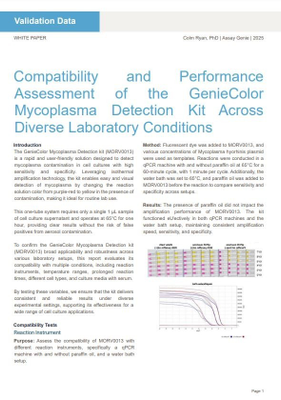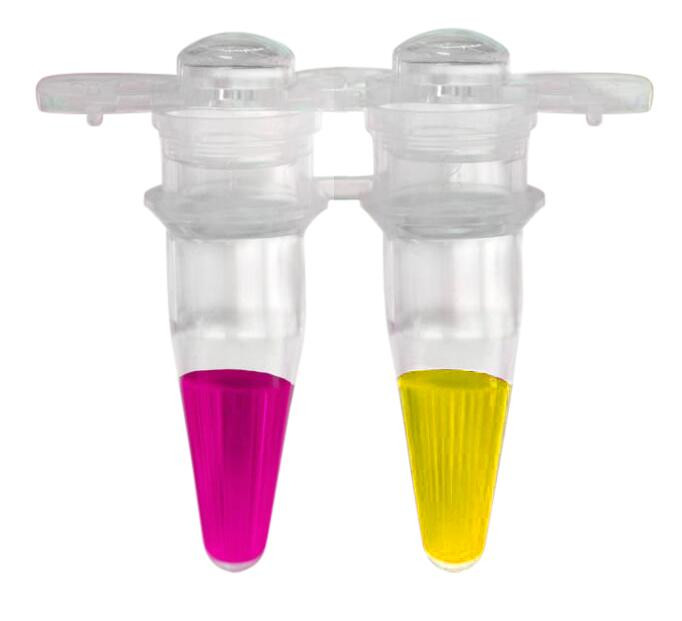Compatibility and Performance Assessment of the GenieColor Mycoplasma Detection Kit Across Diverse Laboratory Conditions
MORV0013 functioned effectively in both qPCR machines and water baths, with or without paraffin oil, maintaining consistent sensitivity and specificity. MORV0013 performed reliably between 60°C and 67°C, ensuring accurate mycoplasma detection even in instruments with varying temperature precision. MORV0013 maintained specificity and accuracy over extended reaction times (2 hours), demonstrating robustness for prolonged testing conditions. MORV0013 successfully detected mycoplasma in multiple cell culture types (suspension and adherent, human and mouse), confirming broad applicability. Different culture media and serum types had no significant effect on amplification speed, sensitivity, or specificity, ensuring reliable performance in varied experimental conditions.
Key Findings:
- MORV0013 functioned effectively in both qPCR machines and water baths, with or without paraffin oil, maintaining consistent sensitivity and specificity.
- MORV0013 performed reliably between 60°C and 67°C, ensuring accurate mycoplasma detection even in instruments with varying temperature precision.
- MORV0013 maintained specificity and accuracy over extended reaction times (2 hours), demonstrating robustness for prolonged testing conditions.
- MORV0013 successfully detected mycoplasma in multiple cell culture types (suspension and adherent, human and mouse), confirming broad applicability.
- Different culture media and serum types had no significant effect on amplification speed, sensitivity, or specificity, ensuring reliable performance in varied experimental conditions.
Compatibility and Performance Assessment of the GenieColor Mycoplasma Detection Kit Across Diverse Laboratory Conditions
Introduction
The GenieColor Mycoplasma Detection kit (MORV0013) is a rapid and user-friendly solution designed to detect mycoplasma contamination in cell cultures with high sensitivity and specificity. Leveraging isothermal amplification technology, the kit enables easy and visual detection of mycoplasma by changing the reaction solution color from purple-red to yellow in the presence of contamination, making it ideal for routine lab use.
This one-tube system requires only a single 1 µL sample of cell culture supernatant and operates at 65°C for one hour, providing clear results without the risk of false positives from aerosol contamination.
To confirm the GenieColor Mycoplasma Detection kit (MORV0013) broad applicability and robustness across various laboratory setups, this report evaluates its compatibility with multiple conditions, including reaction instruments, temperature ranges, prolonged reaction times, different cell types, and culture media with serum.
By testing these variables, we ensure that the kit delivers consistent and reliable results under diverse experimental settings, supporting its effectiveness for a wide range of cell culture applications.
Compatibility Tests
Reaction Instrument
Purpose: Assess the compatibility of MORV0013 with different reaction instruments, specifically a qPCR machine with and without paraffin oil, and a water bath setup.
Method: Fluorescent dye was added to MORV0013, and various concentrations of Mycoplasma hyorhinis plasmid were used as templates. Reactions were conducted in a qPCR machine with and without paraffin oil at 65°C for a 60-minute cycle, with 1 minute per cycle. Additionally, the water bath was set to 65°C, and paraffin oil was added to MORV0013 before the reaction to compare sensitivity and specificity across setups.
Results: The presence of paraffin oil did not impact the amplification performance of MORV0013. The kit functioned effectively in both qPCR machines and the water bath setup, maintaining consistent amplification speed, sensitivity, and specificity.

Page 1
Reaction Instrument
Purpose: Determine the optimal temperature range for MORV0013 and assess performance across a temperature spectrum.
Method: The qPCR instrument was set at 55°C, 60°C, 65°C, 67°C, and 70°C, with varying concentrations of Mycoplasma hyorhinis plasmid as the template. The sensitivity and specificity of MORV0013 were measured to identify temperature compatibility within the specified range.
Results: MORV0013 performed reliably between 60°C and 67°C, demonstrating a broad temperature tolerance suitable for instruments with varying precision levels. The sensitivity and specificity remained consistent across this range, confirming that MORV0013 can detect mycoplasma effectively under diverse thermal conditions.

Long-Time Reaction
Purpose: Test the stability and accuracy of GenieColor Mycoplasma Detection Kit (product code MORV0013) over an extended reaction period versus MycoGenie Rapid Mycoplasma Detection Kit (MORV0011).
Method: Using positive controls from MORV0013, four replicates of negative and positive controls were prepared and reacted at 65°C for 2 hours. The results were assessed by observing any color changes in both positive and negative controls to evaluate the impact of prolonged reaction times.
Results: After the 2-hour reaction, negative controls for MORV0011 and MORV0013, demonstrating that MORV0013 maintains specificity and stability during extended reactions.

Different Cell Samples
Purpose: Comparing GenieColor Mycoplasma Detection Kit (product code MORV0013) effectiveness versus MycoGenie Rapid Mycoplasma Detection Kit (MORV0011) with various cell sample types, including different culture methods and sources.
Method: In 19 µL of MORV0013, 1 µL of cell samples from different culture methods (suspension and adherent) and sources (human and mouse) were added. The reaction was performed at 65°C for 60 minutes, allowing assessment of MORV0013’s compatibility with a diverse range of cell types.
Results: MORV0013 was found to be positive for mycoplasma from all six cell culture fluids. MORV0011 showed no detectable mycoplasma in any of the six samples.

Page 2
MORV0013 tested positive for mycoplasma in samples 3, 5, 6, and 7, with the remaining samples testing negative. MORV0011 showed no detection in all 8 samples.

#1 Jurkat | #2 THP1 | #2 U373 |
#4 A549 | #5 MDA231 | #6 H9c2 |
#7 SW480 | #8 OKT3 |
Different Media and Serum Types
Purpose: Assess the influence of different culture media and serum types on MORV0013’s detection ability.
Method: Using a mycoplasma plasmid as the template, 1 µL of different types of media and serum were added to MORV0013. Reactions were conducted at 65°C for 60 minutes to observe any effects of media and serum on amplification speed, sensitivity, and specificity.
Results: MORV0013 demonstrated compatibility with all tested media and serum types, with no significant impact on amplification speed (ΔCt≤1), sensitivity, or specificity. This confirms that the kit can reliably detect mycoplasma in the presence of various media and serum environments without performance loss.

Conclusion
Instrument and Temperature Compatibility:
MORV0013 showed stable performance across different reaction instruments, regardless of the presence of paraffin oil. It also performed consistently across a broad temperature range of 60°C to 67°C, making it adaptable for instruments with limited temperature precision.
Sample, Media, and Serum Compatibility:
MORV0013 demonstrated excellent compatibility with diverse cell types, culture media, and serum, with no impact on amplification speed (ΔCt≤1), sensitivity, or specificity. Its performance was equivalent to that of Supplier A, confirming its suitability across varied cell culture applications.
Page 3
Meet Some of the Genie Team!
Recent Posts
-
Metabolic Exhaustion: How Mitochondrial Dysfunction Sabotages CAR-T Cell Therapy in Solid Tumors
Imagine engineering a patient's own immune cells into precision-guided missiles against cancer—cells …8th Dec 2025 -
The Powerhouse of Immunity: How Mitochondrial Fitness Fuels the Fight Against Cancer
Why do powerful cancer immunotherapies work wonders for some patients but fail for others? The answe …5th Dec 2025 -
How Cancer Cells Hijack Immune Defenses Through Mitochondrial Transfer
Imagine a battlefield where the enemy doesn't just hide from soldiers—it actively sabotages their we …5th Dec 2025





















